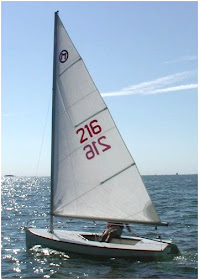I blew off a Classic Moth Regatta the first Saturday in October to attend the MASCF at St. Michaels. My wife surprisingly wanted to come and we rendezvoused with our friends
Chebacco Bob and his wife Glenda at the Festival. Back in 2008, Bob and I did the full three day
MASCF event , me in my Classic Moth, Bob in his Bolger Light Schooner. We camped, like most of the participants, in the small piney wood strip bordering the entrance road to the Museum. We did the informal sailing race on Saturday. A very fun weekend! However, this year, Glenda was wheel chair bound, having broken her leg, so for Bob and I the 2010 MASCF turned into a day trip sans boats.
I generally poke around looking at the small sailing dinghies, canoes, and kayaks. Bob is more interested in larger craft; pocket cruisers, Crotch Island Pinkies and such. My wife, after the obligatory hour watching me immerse myself in boats and more boats, ended up cruising the tourist traps on Main Street.
With all this variety, I like to take the opportunity to test sail something different. This year, thanks to owner John Allen, I sailed on one of the
John Summers/Gilbert 16X30 EZ-build sailng canoes . You need some street cred to be able to con a ride on one of these tippy canoes. Fortunately John Allen had heard about me from
Bill Beaver and I was allowed to take out his pride and joy for a short spin, street clothes and all.
The 16X30 was America's premier racing sailing canoe from the years 1900-1933. In 1933, the International Rules were rewritten and the sloop rigged International Canoe came into being.
On the 16X30, sailing a cat/ketch rig is different, as well as getting used to the pushme/pullyou crosshead tiller (the sliding seat hiking aid would also be different for most other sailors but I've had experience with the International Canoe version).
John has rigged his reproduction 16X30 with modern blocks and lines, carbon spars if you want; a great improvement over the vintage hardware I sailed on one of the early 16X30 Tomahawk reproductions. I found in sailing this plywood 16X30 in 5 to 7 knots that their were no obvious vices. Once I determined how tippy the 34 inch wide hull was, she tacked with authority and small adjustments on the mainsheet kept her on her feet in the puffs. With two low aspect sails and short sliding seat, the Summer/Gilbert certainly was an easier proposition to step into and sail than the International Canoe. I didn't get wet, even my shoes stayed dry!
One of the special thrills in dinghy sailing is being suspended outside the hull (trapeze, wings or sliding seat) and watching the hull slice along. The Summers/Gilbert EZ-build is a probably the best option for a home builder to experience that thrill. It may take a while to master but it's not out of reach for most with reasonable agility.
Thanks again to John for the great ride.
Some pics of John Allen sailing his Summers/Gilbert EZ-build 16X30.


John Allen kibitzing with a spectator. Note how he tethers the 16X30 to the dock by standing on the sliding seat.

Some pics of the small boat dock...........


Tip of the hat to friends I ran into at this years MASCF; Bill Parks, Chuck Sutherland, Marilyn Vogel, and Larry Haff.
I'll cover some of the other sailing craft in upcoming posts.
 George Albaugh beating in his Vintage Dorr Willey.
George Albaugh beating in his Vintage Dorr Willey.
 Joe Bousquet, Rebecca Dudzinsky chasing Jeff Linton offwind.
Joe Bousquet, Rebecca Dudzinsky chasing Jeff Linton offwind.
 Mark Saunders crossing tacks with Jeff Linton.
Mark Saunders crossing tacks with Jeff Linton.
 On shore rigging.
On shore rigging.
 Reach mark congestion.
Reach mark congestion.
 One of the starts.
One of the starts.
 Have a happy New Year!
Have a happy New Year!








































